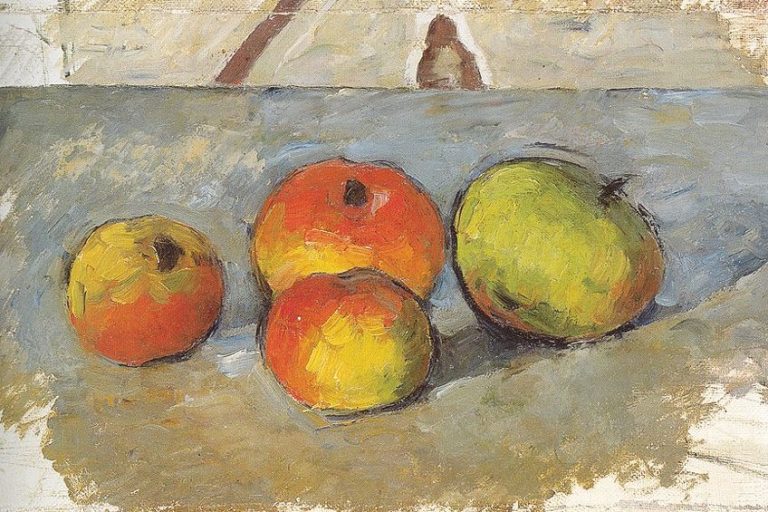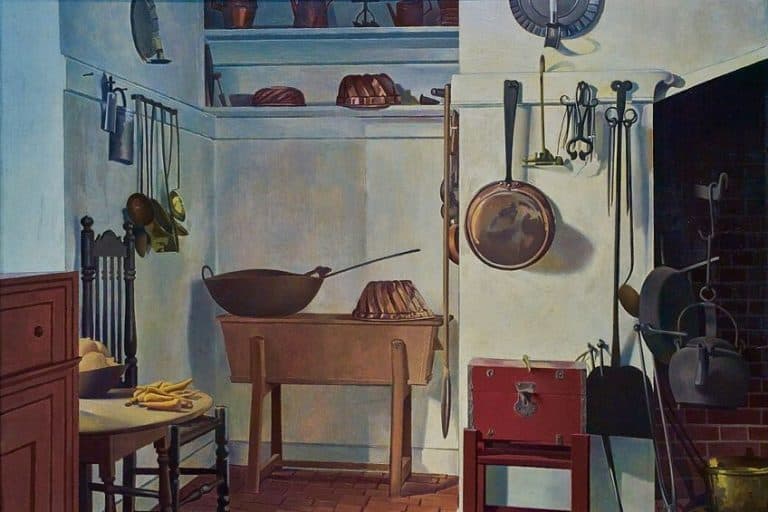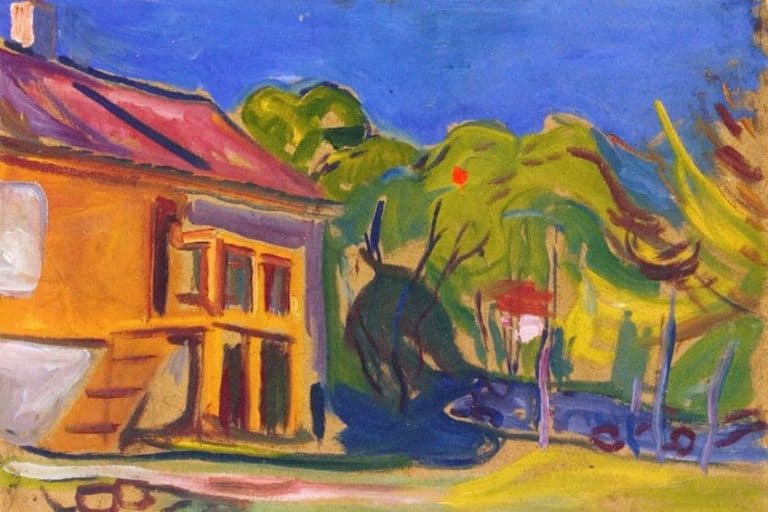Mesoamerican Art – Discover the Important Art of Mesoamerica
Many art lovers derive their references and influence from European and Western masters who offer a lot to learn from. This article will introduce you to another important section of art history called Mesoamerican art, as well as the culture, famous artworks, and interesting discussions around Mesoamerican society. Below, we answer questions such as “what is Mesoamerica?” and highlight some of the defining characteristics of Mesoamerica.
What Is Mesoamerica?
Mesoamerica refers to specific groups of indigenous peoples from multiple countries encompassing Mexico, Honduras, Belize, Costa Rica, Guatemala, El Salvador, and Nicaragua. These indigenous societies existed long before foreigners from Europe made their way to these countries. Mesoamerica spans the southern regions of Northern America and Central America.
These indigenous societies, also called “pre-Columbian” societies, existed since 15,000 BCE and became witness to two of the largest events in global history.
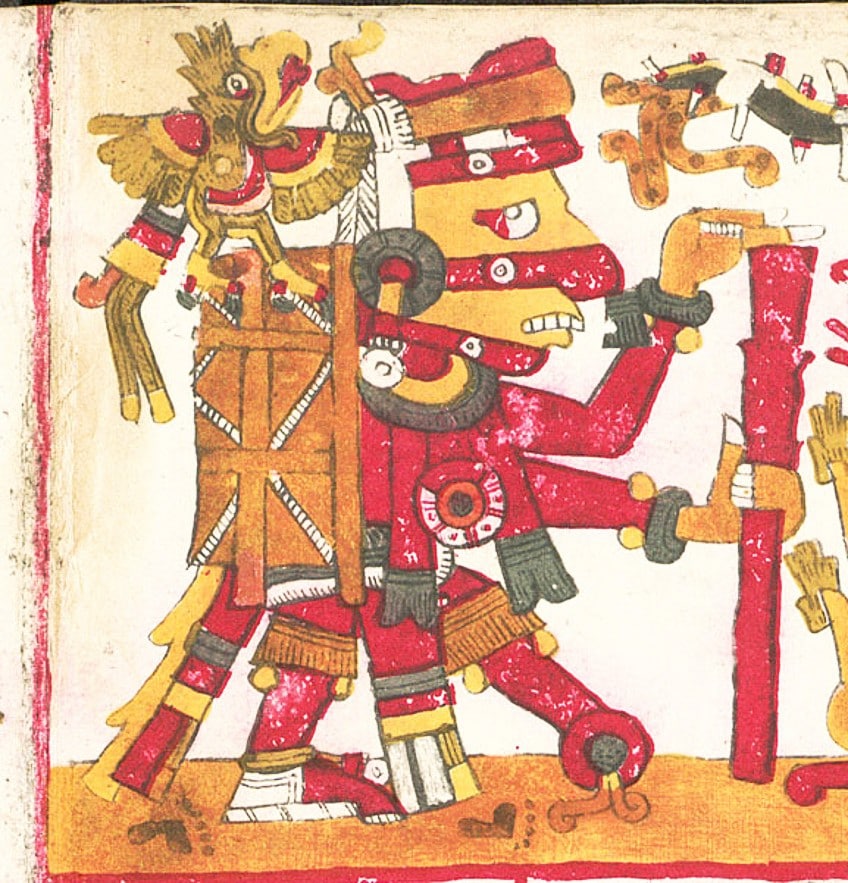
These historical events are what is known to be the primary urban generation and the development of the new world cultures through the integration of European, Asian, African, and indigenous cultures. It can therefore be said that you cannot refer solely to European art history without understanding the depth of the art history that existed before colonization. Along with the entry of the Europeans into North America came new diseases for the indigenous people.
It has been recorded that more than 90% of people from indigenous groups and societies lost their lives to measles and smallpox during the 16th century.
This had a tremendous impact on all the indigenous societies due to the lack of human resources to help keep their society alive. Another interesting fact about Mesoamerica is that it is one of five locations in the world that contain ancient civilizations that thrived on their own. Modern-day Peru is another example of an ancient civilization that emerged independently.
A Mesoamerican Timeline
It is vital to understand that “Mesoamerica” does not refer to one group or one division with multiple sub-groups. The Mesoamerican timeline occurs from the Archaic period at c. 3500 BC to the post-Classic period at 1519 CE.

While the latter date is debated, the majority of Mesoamerican cultural practices slowed down at the beginning of the Spanish conquest in 1519, thereafter evolving under Spanish rule. Below is a table to help you allocate the various Mesoamerican groups into the timeline.
| Dates | Period | Mesoamerican Cultures |
| 3500 – 1500 BCE | Archaic | Unknown distinctions |
| 1800 BCE – 250 CE | Pre-classic | Maya, Zapotec, Teotihuacan, Olmec, Tlatilco |
| 150 – 650 CE | Classic | Maya, Teotihuacan |
| 650 – 900 CE | Epiclassic | Toltec, Maya |
| 900 – 1519 CE | Post-classic | Toltec, Maya, Aztec, Mixtec |
The Emergence of Mesoamerican Culture
Mesoamerican culture is composed of numerous indigenous cultures and includes key developments in agriculture. This included the domestication of animals such as the dog and the turkey as well as various vegetables such as tomatoes, squash, and even staples like maize and cacao.
These historic developments took place around 7,000 BCE and marked the beginning of the transformation of hunter-gatherer-centric people into independent agricultural communities.

Along with this dispersal and agricultural change came more complex developments involving tradition, mythology, religious practices, calendar systems, architectural changes, games, and numerical systems – all considered to be the building blocks of modern society. During the Preclassic era, rapid sedentary development occurred and many Mesoamerican tribes had undergone further stratification and eventually developed chiefdoms.
A chiefdom is defined by an existing political hierarchy that is defined by a specific group of people, usually senior members of a community, and based on the idea of “kinship”.
Culture and Religion in Mesoamerica
We cannot delve into this culture without examining the religious practices of the two predominant religions in Mesoamerican societies. These are the Aztec and Mayan religions that place tremendous importance on the use of cosmology to inform spiritual and ritualistic practices. One of the defining characteristics of Mesoamerica is the use of calendric systems. This was important as it was a crucial tool for many rituals involving the use of time and space with an emphasis on cycles. These cycles involve the cycles of life, death, rebirth, and the rising and setting of the sun.
Within religious beliefs existed a lot of symbolism informed by the order of the universe and Mesoamerican interpretations of this “order”.
The Mesoamerican world tree is an example of a motif that is one of the most important characteristics of Mesoamerica. These world trees are said to represent the quadruple division of the universe, as four cardinal points. These world tree symbols were found across multiple Mesoamerican cultures and not solely between the Mayans and the Aztecs.
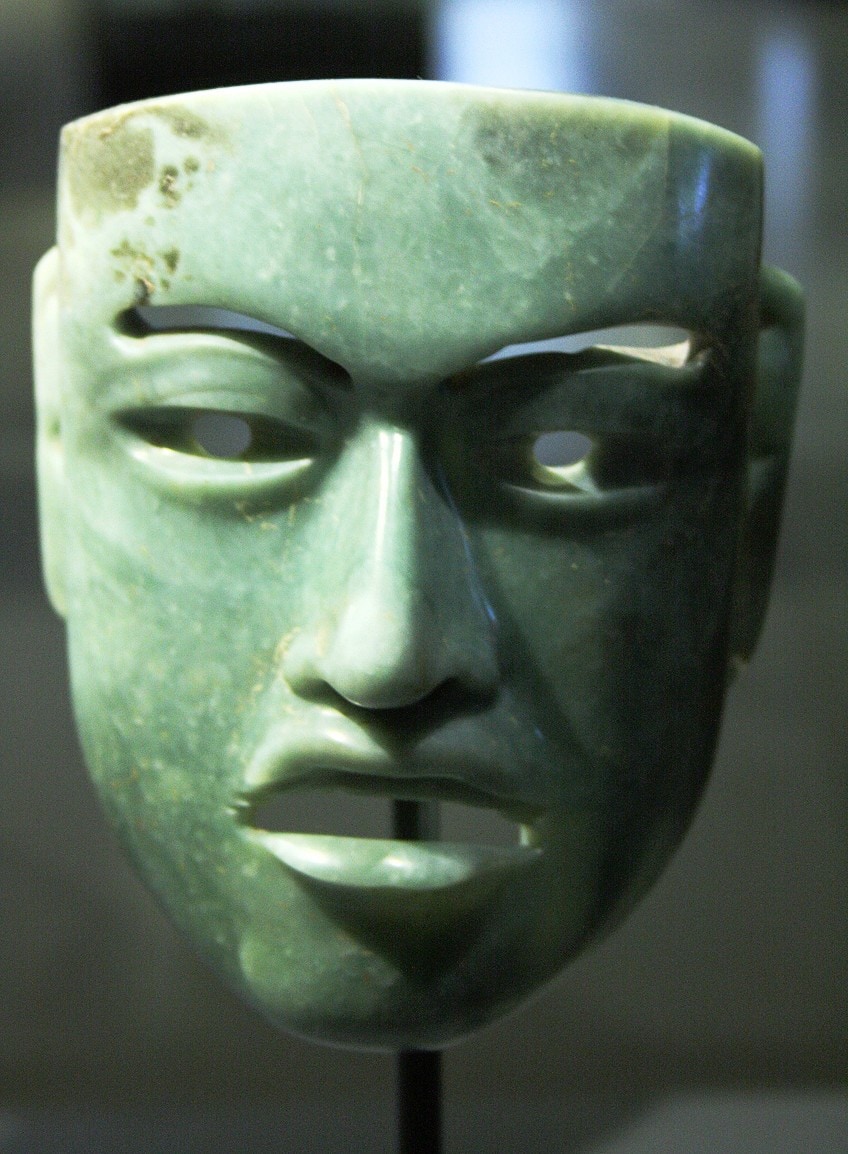
Other Mesoamerican societies include the Olmec, Zapotec, Izapan, Teotihuacan, and Mixtec. For the Mayans, the world tree took the form of the Ceiba tree. Religion was also a key component of the Mesoamerican ball games. This early form of sport was played since 1650 BC and is currently known as “ulama” by the remaining modern indigenous groups.
In some Mesoamerican cultures, the game was so intertwined with rituals that human sacrifice was a part of its rules.
The game was thought to be played by women, men, and children for enjoyment purposes outside of religion. A few ancient Mesoamerican ball courts have been discovered at one of the Mayan archaeological sites in Copán, as well as in modern-day Arizona. The game can be compared to the 1950s version of racquetball created by Joseph Sobek.
Calendric and Numeric Systems of Mesoamerica
Another important cultural development was the Mesoamerican calendar system, which appeared around 500 BCE. The development of the pre-Columbian calendar system was also interlinked with social and religious aspects since religion played a major role across all aspects of life in Mesoamerican tribes.
The calendar system was used primarily for auspicious observances and divination practices.
There were also many types of Mesoamerican calendars, including the 260-day calendar, the 365-day calendar, the central Mexican calendar, the Mayan calendar, and many more sub-calendars for ritual and religious purposes.
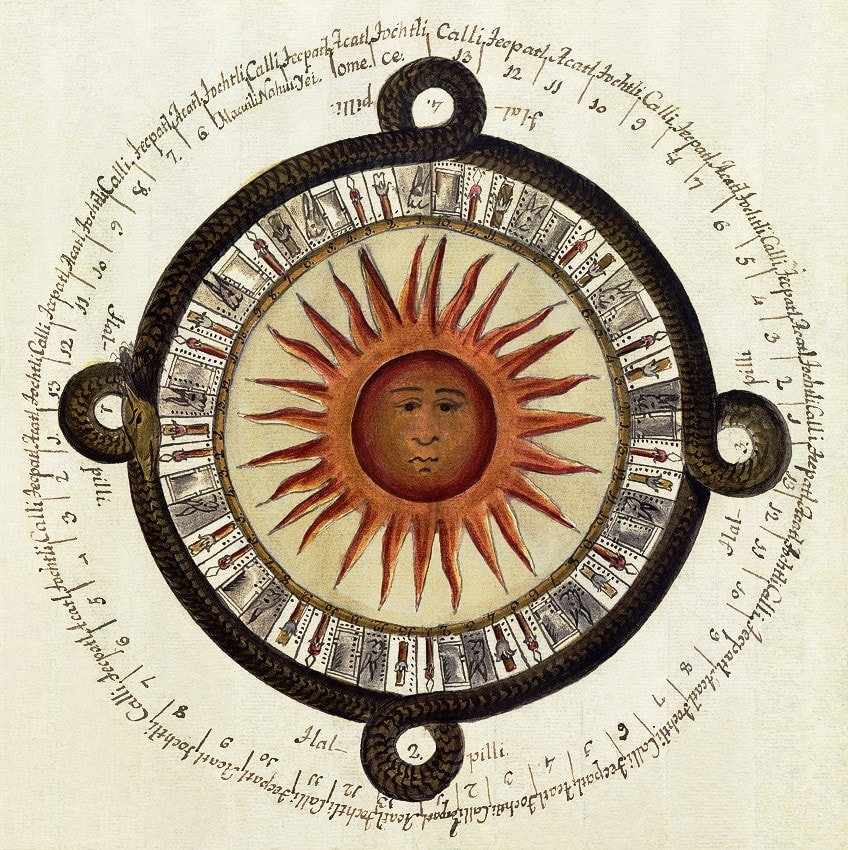
Many of these ancient calendar systems are still in use across Veracruz, Chiapas, Oaxaca, and the highlands of Guatemala. Most ethnographers and colonial travelers who frequented villages in these areas made note of the significance of calendars to indigenous groups.
An astounding fact about the complex Mesoamerican numerical system called the vigesimal numeral system is that it is still found in use across multiple continents.
For example, the vigesimal system can be found in West Africa, Europe, Asia, Oceania, Central Caucasus, and even in geocoding systems such as Open Location Code. The basis of this numeral system is on 20, applied in the same way you would refer to 10 on the decimal system (base-20).
Famous Mesoamerican Art Pieces
Mesoamerican art is rich in diversity, not only from its multi-regional cultures but also from its various mediums and creative use of materials such as ceramic, basalt, clay, and stone. Sculpture and engraving were major mediums for many Mesoamerican cultures.
The majority of Mesoamerican art contained iconography specific to its culture and symbolism.
Some cultures did transfer symbols and meaning to others, demonstrating a connectedness among Mesoamerican societies. The following artworks are a few famous examples of Mesoamerican art that will definitely be remembered by archaeologists and historians.
Izapa Stela 5 (300 – 50 BCE)
| Date | 300-50 BCE |
| Medium | Carved volcanic andesite |
| Location | Soconusco, Chiapas, Mexico |
| Discovered by | Matthew W. Stirling |
| Discovery Date | 1941 |
Izapa Stela 5 is one of many stone carved objects found in Mexico at the famous archaeological site, Izapa. Stelae are defined as stone-carved slabs (sometimes wood) that are usually taller than their width. Discovered and recorded by the Smithsonian archaeologist Matthew Stirling in 1941, the slab appeared to be the most intricately carved object among all the other slabs.
The complex imagery features around 12 individuals, nine deity masks, and more than 25 inanimate or botanical images.
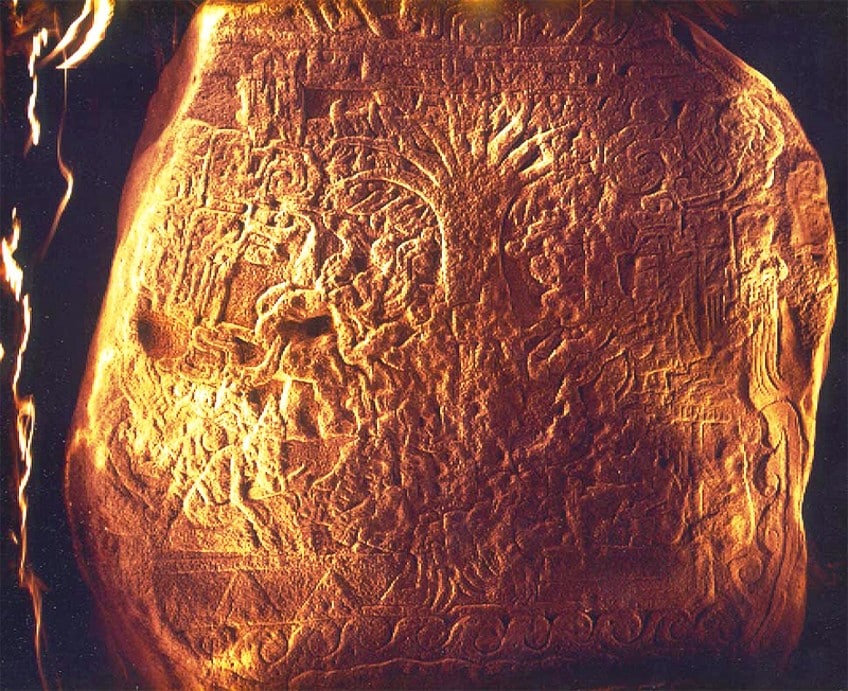
The images also appear to overlap one another, indicating that this was a narrative piece. The central subject on the stela is the world tree and was proposed by American historian and archaeologist, Mary Miller, and Linda Schele, as being a depiction of a creation narrative. The duo also suggested that this was the case since the imagery seems to show humans emerging out of a hole in the tree.
Other interpretations of the imagery on “Izapa Stela 5” include the connection between Mesoamerican societies and trans-oceanic contact.
A theorist named M. Wells Jakeman once claimed that the imager depicted the tree of life as found within the Book of Mormon. This was perhaps a far stretch as the discovery attracted other Mormons who were criticized for disregarding the tablet’s original heritage and placing importance on Mormon symbolism.
Crouching Dwarf Figure (c. 1500 – 400 BC)
| Date | c. 1500 – 400 BC |
| Medium | Greenstone, cinnabar, hematite |
| Dimensions (cm) | 7 (h) |
| Mesoamerican culture | Olmec |
| Period | Early Middle Preclassic |
| Where It Is Housed | Snite Museum of Art |
Mesoamerican sculpture includes mainly human figures and deities but the crouching dwarf or the dwarf as a visual in general is one of the most iconic images of the Olmec culture. Art from the Olmec culture is characterized by elements of realism and many ancient creators drew inspiration from their natural surroundings. Among relief carvings, infants, dwarfs, and anthropomorphic figures, the art of Olmec can be said to be a combination of mythology, the supernatural, and the human figure.
According to a research paper by Tara D. Smith in 2017, it is theorized that the figure of the dwarf may be representative of liminality.
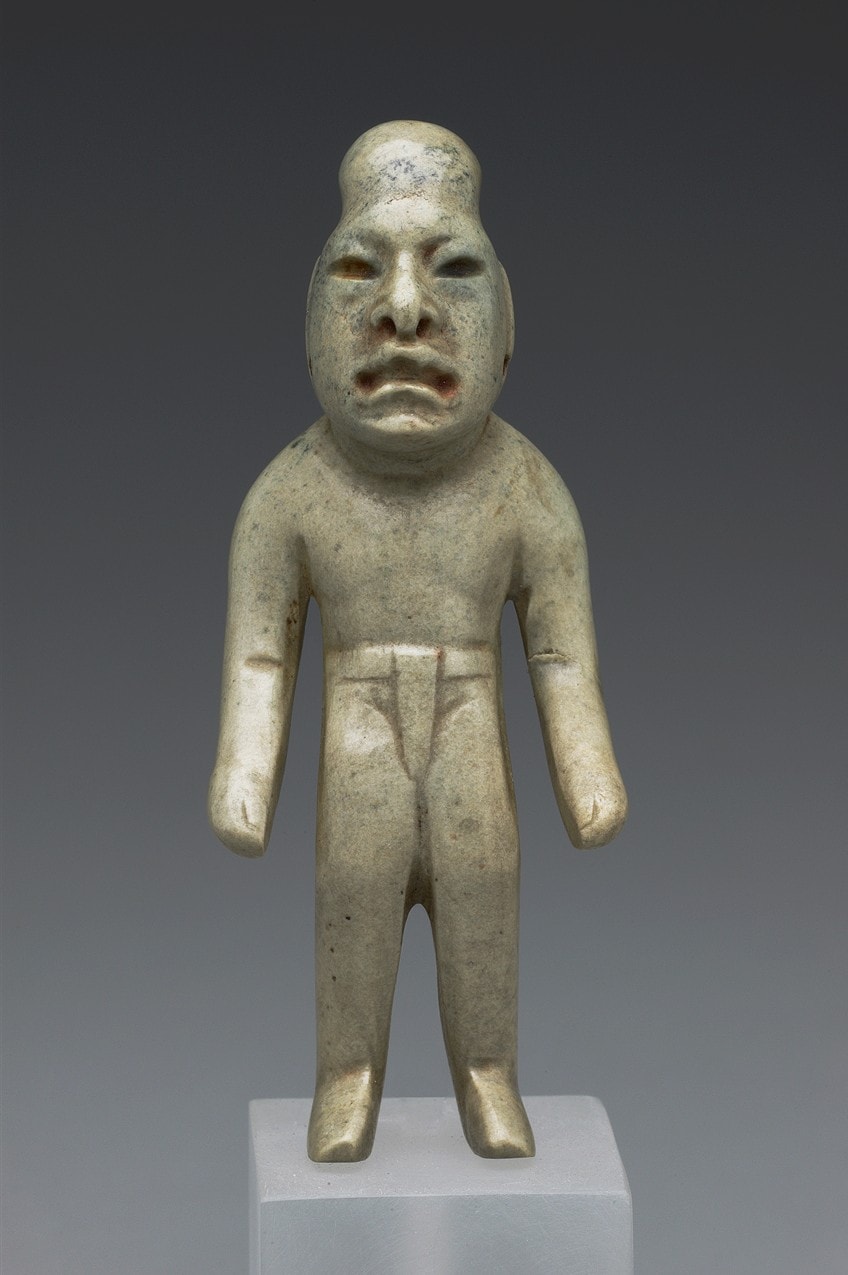
Originating in La Venta, the symbol of the dwarf was seen in massive sandstone monuments within an area of trade and most likely built out of the influence of other Mesoamerican cultures. The dwarf is also said to be related to ballgames, which is also linked to the playing court as being a symbol of the cosmos and hence, an act of creation. Further analyses of the dwarf as a symbol and art object include relations to the dwarf as an intermediary between the physical Earth and the heavenly “divine”.
The crouching dwarf on the other hand could be symbolic of human development in the embryonic stages and representative of human development – another nod to the importance of cycles.
The Wrestler (c. 1500 – 400 BC)
| Date | c. 1500-400 BC |
| Medium | Basalt |
| Dimensions (cm) | 66 (h) |
| Mesoamerican culture | Olmec |
| Discovered in | 1933 |
| Where It Is Housed | Museo Nacional de Antropología, Mexico City |
Formally recognized as Antonio Plaza Monument 1, this sculpture is a unique artwork to its culture. The sculpture shows a man seated with his legs crossed with both arms bent as if in a “wrestler” position. The sculpture appears to be a personal portrait of a man affiliated with the political hierarchy of the culture. This is depicted through his goatee and mustache.
The sculpture also resembles a likeness to that of a painting of a Timucua ritual, painted by Jacques le Moyne de Morgues, a French artist.
In addition to lacking the traditional iconography found in a vast majority of art from the Olmec culture, the sculpture has a narrow base, more detail to features like the foot, and a potentially “imported” material (basalt).

The Wrestler received a great deal of praise from historians and archaeologists, claiming that it is “the finest of all sculptures” out of all other discoveries classified as Olmec. The government of the United Mexican States also recognized the importance of the sculpture, preserving its significance on the front face of a one-ounce silver coin in 1996.
Given that most Mesoamerican sculptures and art objects managed to survive the invasion of the Spanish, many remaining monuments expressed themes pertaining to the veneration of religious deities, time, and appreciation of the city.
Many rulers followed the same pattern of erecting sculptures and monuments in glorification of themselves, the city, or as an architectural development. Art, therefore, became so closely enmeshed with politics that the product of anything political was translated into a work of art to carry religious or political meaning.
Tlaloc Mask (c. 1350 – 1521)
| Date | c. 1350 – 1521 |
| Medium | Wood, shell, turquoise, resin, lignite |
| Dimensions (cm) | 19.53 x 16.04 x 9.21 |
| Mesoamerican culture | Mixtec-Aztec |
| Period | Late Post-classic |
| Where It Is Housed | Dallas Museum of Art, Dallas, Texas |
The Valley of Mexico in 1325 was home to the beginning of the Aztec Empire, which was the last of the largest indigenous Mesoamerican tribes. Now known as Mexico City, Tenochtitlan was the site from which Aztec culture and authority infiltrated almost all parts of Mexico. Aztec art often featured ritualistic practices such as human sacrifices, often displayed on detailed stone sculptures and smaller works such as the mask seen above, using precious, ornate materials, ceramics, and stones.
The mask above is decorated in a turquoise mosaic style that was originally a stylistic element derived from the Mixtec culture of Oaxaca.

This embellishment is also featured on other objects such as staffs, sacrificial weapons, shields, and protective gear. This mask has been identified as part of the Tlaloc culture since the circles surrounding the eye area of the mask seem to resemble one of the Tlaloc Gods.
The addition of turquoise gives the God’s identity away, as it was symbolic of the blueness of the water, the importance of life, and the blue sky, all associated with the storm and rain God.
It is believed that these masks were part of the attire of those who impersonated the Gods and even featured in deity imagery. It has also been reported that these turquoise-decorated masks are part of burial ceremonies and an acknowledgment of highly respected ancestors. Masks like the one above have been discovered in Oaxaca on “bundled bodies”.
Paintings of Mesoamerica
Below you will find a list of iconic Mesoamerican paintings found at important archaeological sites in Mexico. One such example is the temple of murals and a site called San Bartolo, where a team headed by William Saturno discovered Mesoamerican paintings that dated back to 100 BC.
| Title | Location | Date | Discovered |
| Great Goddess of Teotihuacan mural | Tetitla, Mexico | c. 100 BCE – 700 CE | 1942 |
| Paradise of Tlaloc | Mesoamerican ruins of Teotihuacan | c. 450 – 600 AD | c.1942 |
| Scene of the Maya royal court on Lord of the jaguar pelt throne vase | National Gallery of Victoria, Melbourne | c. 700 – 800 AD | 2002 |
| Painted relief of the Maya site Palenque, featuring the son of K’inich Ahkal Mo’ Naab’ III | Palenque Site Museum, Mexico | c. 678 – 729 AD | N/A |
| Aztec legend of the foundation of Tenochtitlán from Codex Mendoza | Bodleian Library, Oxford University | c. 1553 | N/A |
Mesoamerican Art by Region
It is important to note that Mesoamerican art cannot be used about a collective society since there are many groups of indigenous cultures, each with their unique artistic expression. Below, you will find some interesting insights on Mesoamerican art found in the different regions across early Mesoamerica.
Central and Western Mexican Art
Both Mesoamerican cultures within Central and West Mexico produced artwork that dealt with the human figure and included monumental structures, tombs, clay, ceramic, and stone sculptures and vessels. The art of Mesoamerica cannot be studied without its architecture since a lot of decorative elements of important monumental architecture also featured on many objects considered artwork.
Around 200 to 500 CE, cultures based in Jalisco, Colima, and Nayarit created hollow tomb sculptures out of clay and included other hollow vessels shaped to resemble dogs, warriors, human figures, and parrots.
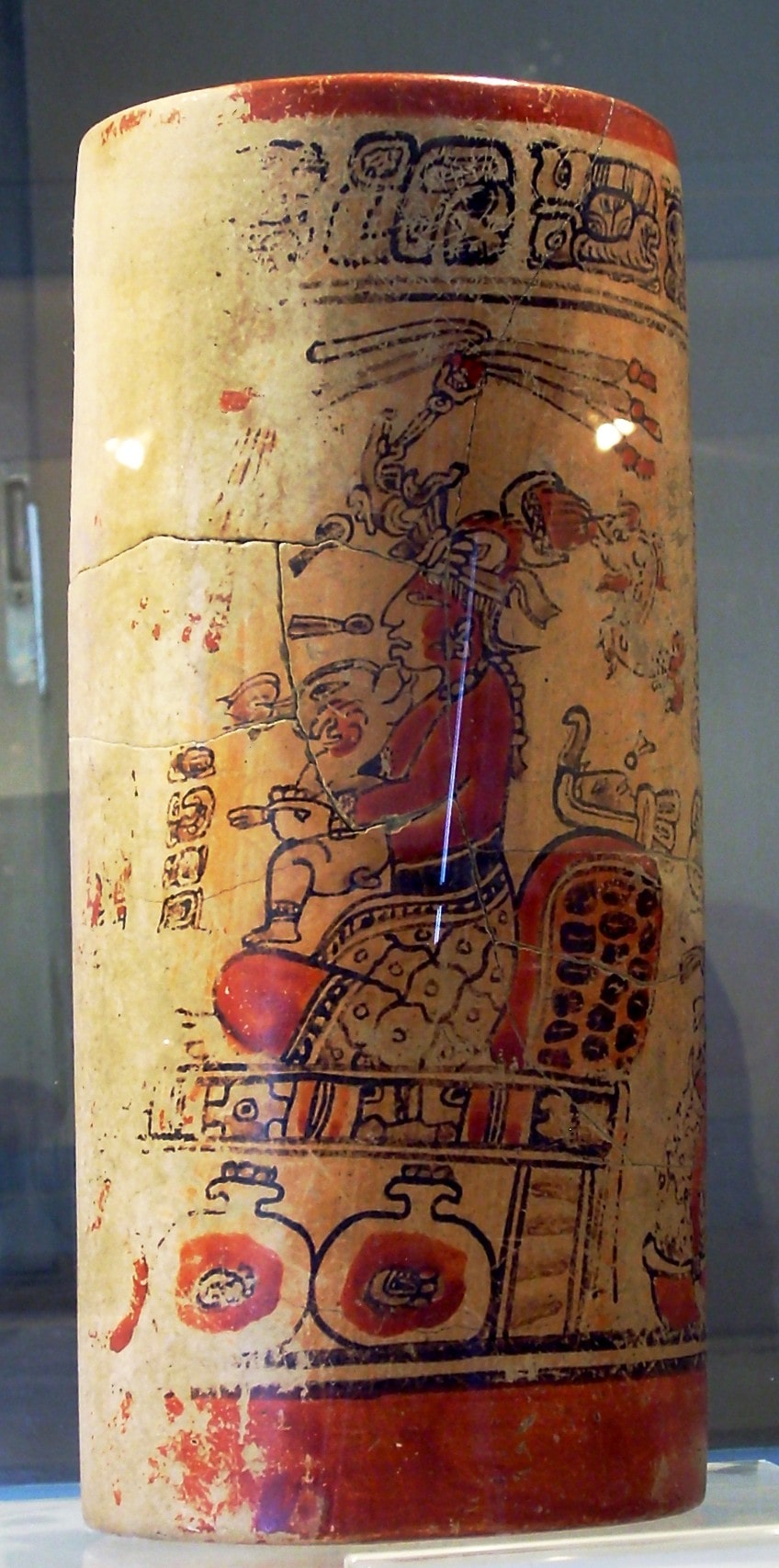
As time progressed, other civilizations emerged and by the Classic period, central Mexico’s population had reached new heights of 250,000 people. The city had to expand and many new structures appeared, including the Sun and Moon pyramids, a grid-like layout, and ornamentally designed architecture. Some of these structures were decorated with stucco pigments and some freehand designs. Designs included key deities such as Tlaloc and Spider Woman.
The Mesoamerican sculpture process also gained new methods of production and involved an initial model of a figure by hand and later through molds.
Later, many artists of Teotihuacán exported these figures to other Mesoamerican regions via functional cylinder-shaped tripod vessels – how inventive? Unfortunately, by c. 650 to 800 CE, the Teotihuacán culture gradually declined and reached its end, marking the end of the Classic era.
Mesoamerican Art of Southern Mexico
The Zapotecs were situated in Oaxaca in the capital of Monte Albán. Elements of art are also featured in their architecture on building faces with the development of two-dimensional reliefs. These reliefs served to commemorate the previous and existing rulers and conquests.
Public art was not the only display of the sculptural skill possessed by the Zapotec artisans.

Urns made for the high-class dead featured three-dimensional figures followed by exquisitely painted tombs, reserved for the noble. Meanwhile, in the southernmost regions occupied by the Totonacs, artisans were producing life-sized hollow sculptures modeled after humans and Gods.
Mayan and Aztec Art
Much of the Mayan art included stelae with engravings of Gods and members of the hierarchy. From c. 200 to 900 CE, art within this region had been the subject of experimentation among other elements such as architecture and text. The highland areas created a writing system alongside the stelae drawings while the lowland areas focused on making massive stucco masks on pyramids.
The marriage of ruler imagery with glyphic narratives of local history was a key trait of Classic Mayan culture.
Some of the most interesting monochromatic paintings can be seen at Río Azul and Tikal, depicting scenes from the underworld and tomb walls decorated with black and red paintings. By this period, ball courts made out of stone were a staple of most Mesoamerican architectural plans.
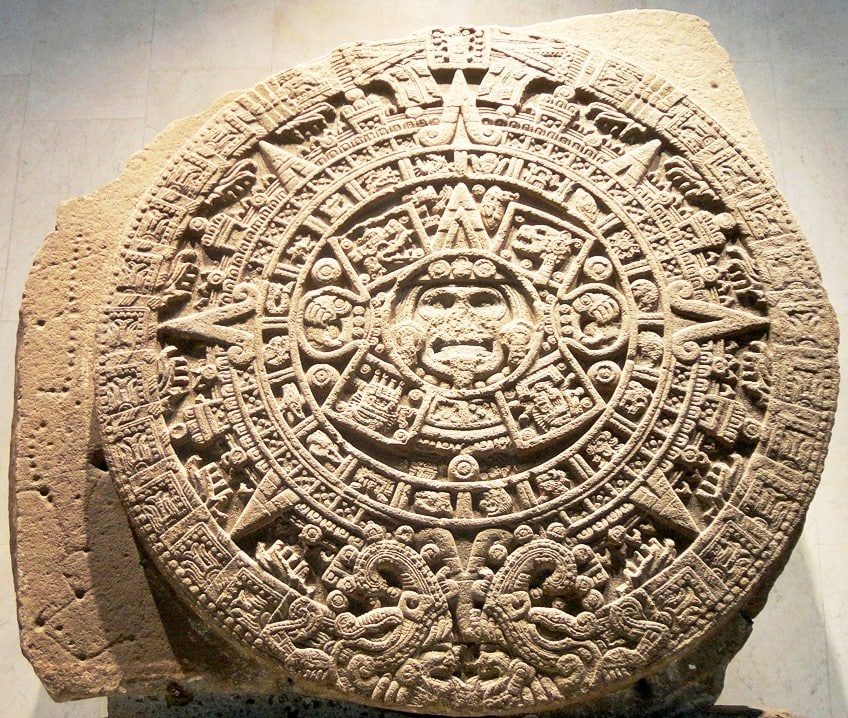
The sixth century was witness to much war and halted the progression of Mayan art. King Pacal the Great of Palenque issued the construction of a wall sculpture that required multiple compositions with many figures. The King even prepared a memorial Temple of Inscriptions for his death, which highlights the way that art was used as a demonstration of power. Perhaps you may find examples of art as a display of power today.
Cast your attention to the Aztecs at Tenochtitlán, in c. 1345 the majority of Mesoamerica was dominated by the Aztecs before the arrival of the Spanish. Art for the Aztecs reflected the cosmology and Gods who the people praised for their people’s wealth. Templo Mayor is one such example, and now a UNESCO world heritage site, depicting the artisan talent of the Aztecs and their devotion to Gods such as the sun God, the wind God, Tlaloc, and the feathered serpent creator. Large basalt sculptures graced the confines of the structure, with both two-dimensional and three-dimensional features.
Also, the highlight of all sculptures was the calendar stone that documented the ages of destruction.
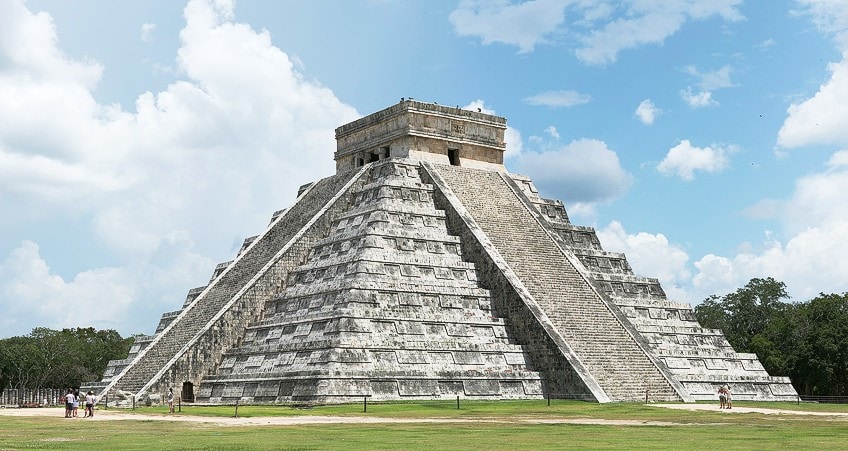
Finer details on smaller sculptures such as organic animal forms and vegetation featured on semi-precious stones. If the site could not get any more elaborate, portraits of rulers were found carved onto the rocks around Chapultepec. Artistic expression was also present in jewelry made from precious metals.
Many of these pieces were found embellished in jade, greenstone, turquoise, coral, and even obsidian.
Ceremonial outfits also contained elements of creative flair. These included the works of feather artisans who crafted tilmas (known as a tilmàtli) out of cotton cloths for the noble class. A famous portrait of Emperor Moctezuma II wearing a colorful tilmàtli was painted by Antonio Rodriguez titled, Portrait of Moctezuma II (1466-1520).
The art of Mesoamerica is definitely an incredible display of variety and imagery informed by influential figures, cultural practices, and mythological beliefs. Closely intertwined with art, architecture, and religion, Mesoamerica provided some of the most exquisite archaeological discoveries through sculpture and monumental architecture. It is essential to remember that these examples of Mesoamerican practices and art forms are only the tip of the iceberg since there are many more Mesoamerican societies, each with their distinct practices. We hope that the complexity of Mesoamerican culture and art has inspired you to search for alternative art histories as a means to draw connections between architecture, religion, and art practice.
Frequently Asked Questions
What Language Did People in Mesoamerica Speak?
Although Mesoamerica is used as an umbrella term, linguists have speculated that there are more than 125 languages that were spoken by the different Mesoamerican tribes. No cultural group spoke the same language.
Which Deities Did Most Mesoamerican Cultures Share in Common?
Most Mesoamerican cultures shared similar Gods, the most common being Tlaloc, the storm and rain God, King Pacal the Great of Palenque, and a deity called Quetzalcoatl, which was a serpent covered in feathers.
Which Mesoamerican Culture Invented the Ballgame?
The ballgame was first played by the Olmecs in a ballcourt situated in a sacred area of the city to draw attention to the significance of playing the game. The ballgame was so important that some cultures ensured to play the game as an alternative to going to war.
Isabella studied at the University of Cape Town in South Africa and graduated with a Bachelor of Arts majoring in English Literature & Language and Psychology. Throughout her undergraduate years, she took Art History as an additional subject and absolutely loved it. Building on from her art history knowledge that began in high school, art has always been a particular area of fascination for her. From learning about artworks previously unknown to her, or sharpening her existing understanding of specific works, the ability to continue learning within this interesting sphere excites her greatly.
Her focal points of interest in art history encompass profiling specific artists and art movements, as it is these areas where she is able to really dig deep into the rich narrative of the art world. Additionally, she particularly enjoys exploring the different artistic styles of the 20th century, as well as the important impact that female artists have had on the development of art history.
Learn more about Isabella Meyer and the Art in Context Team.
Cite this Article
Isabella, Meyer, “Mesoamerican Art – Discover the Important Art of Mesoamerica.” Art in Context. August 12, 2022. URL: https://artincontext.org/mesoamerican-art/
Meyer, I. (2022, 12 August). Mesoamerican Art – Discover the Important Art of Mesoamerica. Art in Context. https://artincontext.org/mesoamerican-art/
Meyer, Isabella. “Mesoamerican Art – Discover the Important Art of Mesoamerica.” Art in Context, August 12, 2022. https://artincontext.org/mesoamerican-art/.





